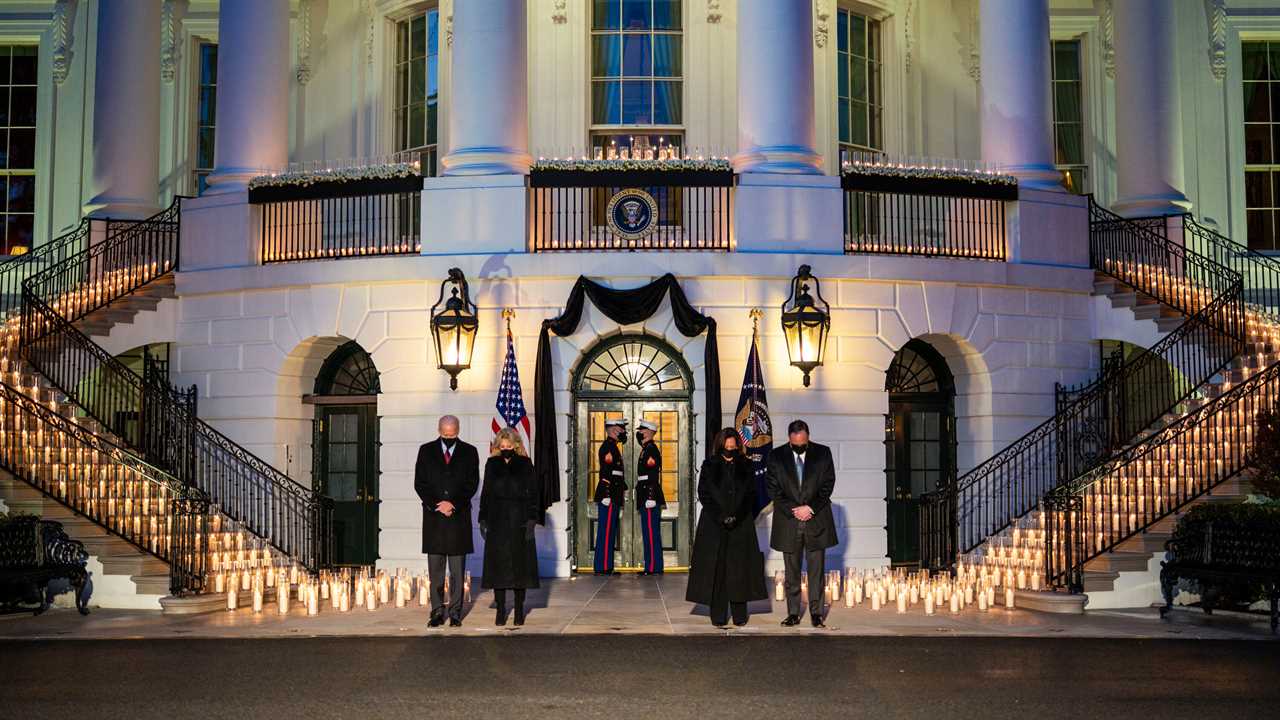
WASHINGTON — President Biden urged the nation on Monday night to “resist becoming numb to the sorrow” that the novel coronavirus had inflicted, marking the staggering milestone of more than a half-million Americans dead from the pandemic in a solemn ceremony at the White House.
The country passed the grim toll around 5 p.m., and bells began tolling at the National Cathedral, resounding across a capital with flags lowered to half-staff. About an hour later, Mr. Biden appeared in the Cross Hall of the White House and pulled a card from his jacket pocket that he said was updated each day with the number of those infected — and those who died — from Covid-19.
Speaking somberly and drawing on his own personal experience, Mr. Biden sought not only to honor the dead, but also to comfort those who have lost loved ones, many of whom “took their final breath alone.”
Looking into the camera, the president addressed the survivors directly, alluding several times to the loss of his first wife, an infant daughter and, later, his eldest son.
“I know all too well,” he said. “I know what it’s like to not be there when it happens. I know what it’s like when you are there holding their hands; there’s a look in their eye and they slip away. That black hole in your chest — you feel like you’re being sucked into it. The survivors remorse, the anger, the questions of faith in your soul.”
It was a strikingly emotional moment, and a testament to a nation’s failure to act in the face of a calamity that would take the lives of more Americans in a year’s time, Mr. Biden noted, than died in World War I, World War II and the Vietnam War combined. “More lives lost to this virus,” he said, “than any other nation on Earth.”
Later, Mr. Biden and his wife, Jill Biden, along with Vice President Kamala Harris and her husband, Douglas Emhoff, exited the White House en route to the South Lawn through a door that was draped in black cloth; the stairs leading up to the Truman Balcony were seen dotted with votive candles.
The two couples, wearing black masks, bowed their heads in a moment of silence as a military band played “Amazing Grace.” When the music stopped, the president made the sign of the cross and turned to walk back inside.
The White House ceremony was particularly notable because President Donald J. Trump refused to mark the losses or hold such remembrances, knowing that any focus on the individual lives lost would quickly raise the question of how the government failed to respond more quickly and aggressively.
But in October, Mr. Trump did appear in much the same spot when he returned home from the hospital after being treated for Covid-19, removed his mask and walked inside — even as he was still most likely infectious.
Latest Updates
- Here is how Covid-19’s toll compares with other causes of death in the U.S.
- Fauci says antiviral drugs will be key in the next phase of battle against Covid.
- Entering uncharted territory, the U.S. counts 500,000 Covid-related deaths.
Time after time, Mr. Trump played down the virus, first arguing that it would disappear, then that it would be contained to a few lives would be lost, and then boasting that his government would hold the death count to “substantially below the 100,000” mark. At one point, he told the journalist Bob Woodward that he would not talk about the dangers “to reduce panic.”
As a presidential candidate, Mr. Biden consistently warned of the hard times that were ahead, even as he pledged that combating the virus would be his No. 1 priority if he were elected. Now, a month into his term in office, he owns the response. And he is already facing critics who question whether he set the bar for vaccinations too low, and if he is moving too slowly to clear roadblocks to getting millions of Americans vaccinated every day.
The average now is about 1.7 million vaccines administered daily, which the White House press secretary, Jen Psaki, noted on Monday was roughly twice the daily vaccination pace as when Mr. Biden was inaugurated.
And by Monday, the number of Covid deaths being reported, on average, on most days was cut by roughly half since the peak of more than 3,300 in January. The slowing came as a relief, but scientists said variants of the virus made it difficult to project the future of the pandemic, and both Mr. Biden’s new team of medical advisers and historians cautioned against turning away from the scale of the country’s losses.






